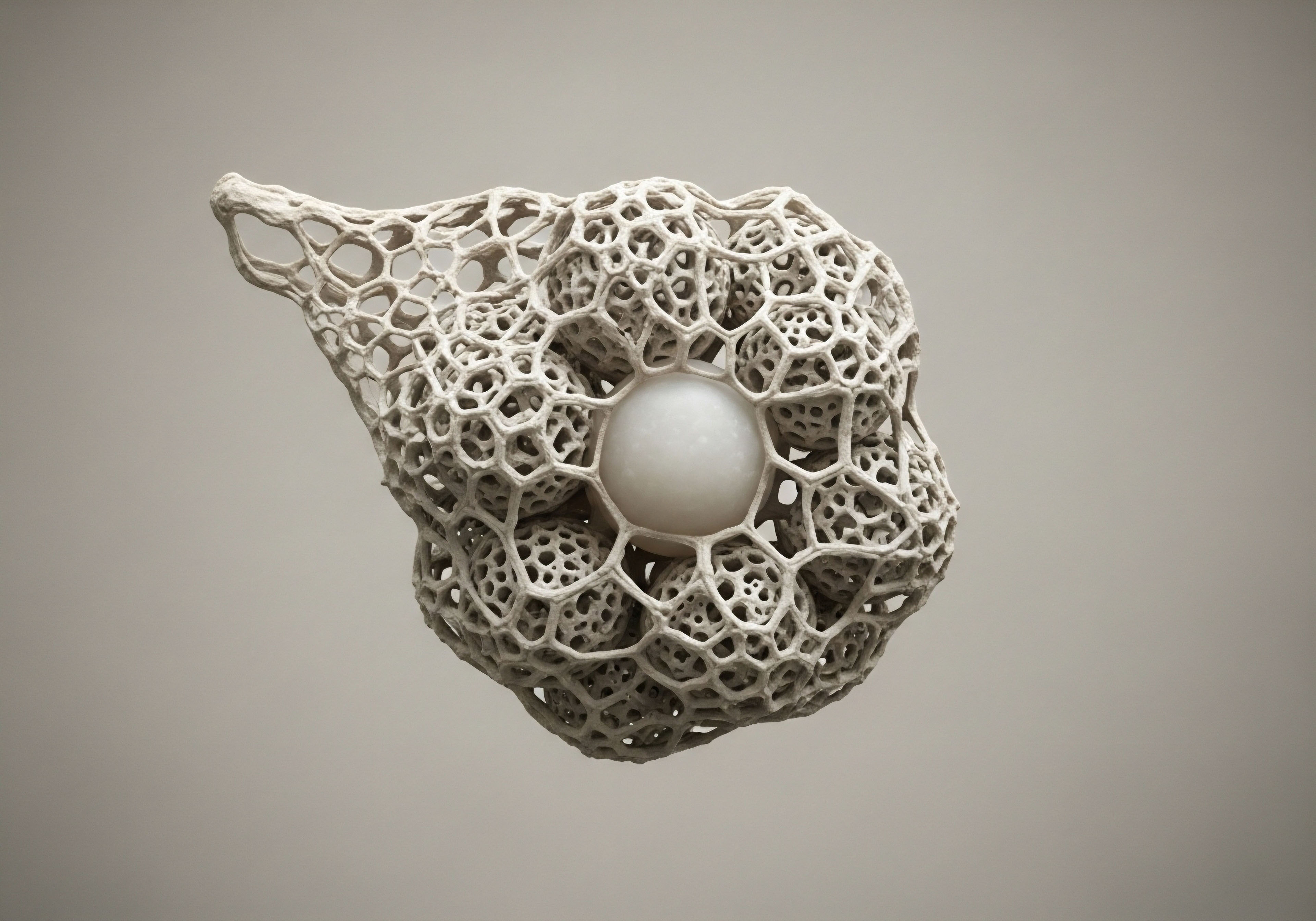

Fundamentals
You feel it in your bones, a subtle shift in the way your body responds to the world. The energy that once came easily now feels distant. Sleep, which should be restorative, offers little relief. Your internal landscape feels unfamiliar, and the reflection in the mirror seems disconnected from the vitality you feel you should possess.
This experience, this deep-seated sense of being out of sync, is a valid and powerful signal from your body. It is the language of your internal communication network, a system of profound intelligence that governs everything from your mood to your metabolism. This network operates through chemical messengers, molecules that carry precise instructions to every cell, tissue, and organ. We are talking about the endocrine system, and its messengers are hormones and peptides.
Understanding this system is the first step toward reclaiming your biological sovereignty. Your body functions as an intricate, interconnected whole, where balance is maintained through constant conversation. Hormones and peptides are the words and sentences in that conversation. They are released from specialized glands and travel through your bloodstream, seeking out specific recipient cells.
Upon arrival, they dock with a receptor, a specialized protein structure on the cell’s surface or within its core. This docking action is like a key fitting into a lock, initiating a cascade of events inside the cell.
The cell is then instructed to perform a specific task, perhaps to burn more fat for energy, build new muscle tissue, or regulate your sleep-wake cycle. The entire process is a testament to the body’s inherent drive toward equilibrium, a state known as homeostasis.
The body’s endocrine system uses hormones and peptides as chemical messengers to maintain a state of internal balance or homeostasis.
The regulation of this chemical conversation relies on a principle of feedback. Think of it as a highly sophisticated thermostat for your biology. The brain, specifically a region called the hypothalamus, acts as the central command. It constantly monitors the levels of various hormones in your bloodstream.
When it detects that a particular hormone level is too low, it sends a signal to the pituitary gland, the master control center located just below it. The pituitary, in turn, releases its own signaling hormones that travel to a specific target gland, such as the thyroid, adrenals, or gonads (testes in men, ovaries in women).
This prompts the target gland to produce and release its specific hormone. As the level of this final hormone rises in the bloodstream, the hypothalamus and pituitary detect the increase and reduce their own signaling. This is a negative feedback loop, a fundamental mechanism that ensures hormone levels remain within a precise, healthy range. It is an elegant, self-regulating circuit that keeps your entire system running smoothly.

The Messengers and Their Roles
The messengers themselves come in different forms, primarily categorized by their chemical structure. This structure dictates how they travel through the body and how they interact with their target cells. Understanding this distinction is key to appreciating how different therapeutic protocols work.

Steroid Hormones a Foundational Force
Steroid hormones are derived from cholesterol. This lipid-based structure allows them to pass directly through the cell membrane, which is also made of lipids. Once inside, they travel to the cell’s nucleus, its genetic command center. There, they bind to receptors and directly influence which genes are turned on or off.
This process, called gene expression, results in the creation of new proteins that alter the cell’s function in a powerful and lasting way. Testosterone, estrogen, progesterone, and cortisol are all examples of steroid hormones. Their ability to directly edit a cell’s protein-manufacturing instructions is why their effects on body composition, mood, and reproductive health are so significant.

Peptide Hormones Swift and Specific Signals
Peptide hormones are made from chains of amino acids. They are water-soluble, which means they travel easily through the bloodstream but cannot pass through the lipid-based cell membrane. Instead, they bind to receptors on the outer surface of the cell.
This binding action triggers the activation of a “second messenger” system inside the cell, often involving a molecule like cyclic AMP (cAMP). This second messenger relays the signal inward, setting off a rapid chain reaction that alters the cell’s activity. Insulin, growth hormone, and the hypothalamic and pituitary signaling hormones are all peptides.
Their effects are typically faster to initiate than those of steroid hormones, making them ideal for processes that require quick adjustments, like regulating blood sugar or releasing other hormones.
Your personal experience of well-being is directly tied to the efficiency and clarity of these signaling pathways. When the messengers are produced in the right amounts, at the right times, and the recipient cells are listening intently, you feel vibrant, resilient, and whole.
When the signals become faint, confused, or the receiving mechanisms become dull, the symptoms you experience are the direct result. The journey to optimized health is one of listening to these signals and learning how to restore the conversation.


Intermediate
To move from understanding the body’s feedback systems to actively supporting them requires a more granular look at the specific axes of communication and the clinical tools designed to interact with them. When symptoms of hormonal imbalance persist, they often point to a disruption within a specific feedback loop.
A clinically guided protocol is designed to intervene at a precise point in that loop, restoring the clarity of the signal and re-establishing systemic equilibrium. This intervention is a process of biochemical recalibration, grounded in objective laboratory data and your subjective experience of health.
The two most prominent axes we address in personalized wellness are the Hypothalamic-Pituitary-Gonadal (HPG) axis, which governs reproductive health and vitality, and the Growth Hormone (GH) axis, which regulates cellular repair, metabolism, and physical composition. Each axis has its own set of messengers and a unique rhythm, and therefore requires a tailored approach to its optimization.

The Hypothalamic Pituitary Gonadal Axis a Core Regulator
The HPG axis is the central control system for sexual development and reproductive function in both men and women. Its operation is a classic example of a multi-tiered negative feedback loop. The process begins in the hypothalamus with the pulsatile release of Gonadotropin-Releasing Hormone (GnRH).
GnRH travels to the anterior pituitary gland, stimulating it to release two key gonadotropins ∞ Luteinizing Hormone (LH) and Follicle-Stimulating Hormone (FSH). These hormones then travel to the gonads. In men, LH stimulates the Leydig cells in the testes to produce testosterone, while FSH supports sperm production.
In women, LH and FSH orchestrate the menstrual cycle, triggering ovulation and stimulating the ovaries to produce estrogen and progesterone. The sex hormones produced by the gonads, testosterone and estrogen, then circulate back to the brain, signaling the hypothalamus and pituitary to decrease their output of GnRH, LH, and FSH, thus completing the loop.
Disruptions in the Hypothalamic-Pituitary-Gonadal axis are a primary cause of symptoms related to hormonal decline in both men and women.

Addressing Male HPG Axis Dysfunction
In men, a decline in testosterone production, or hypogonadism, can disrupt this entire system, leading to fatigue, reduced muscle mass, low libido, and cognitive changes. A comprehensive therapeutic protocol seeks to restore balance by addressing multiple points within the HPG axis.
- Testosterone Cypionate This is the foundational component of male hormonal optimization. As an exogenous form of testosterone, it directly replenishes the body’s primary androgen, alleviating the systemic symptoms of low levels. It is typically administered via weekly intramuscular or subcutaneous injections to maintain stable serum concentrations.
- Gonadorelin When the body receives an external source of testosterone, its natural production via the HPG axis feedback loop diminishes. The hypothalamus reduces GnRH signals, leading to decreased LH and FSH, which can cause testicular atrophy and reduce fertility. Gonadorelin, a synthetic analog of GnRH, is used to counteract this. Administered via subcutaneous injection, it directly stimulates the pituitary gland to continue producing LH and FSH, thereby maintaining natural testicular function and size.
- Anastrozole Testosterone can be converted into estradiol, a form of estrogen, through an enzyme called aromatase. In some men on testosterone therapy, this conversion can become excessive, leading to estrogen-related side effects like water retention or gynecomastia. Anastrozole is an aromatase inhibitor, an oral medication that blocks this conversion pathway, helping to maintain a healthy testosterone-to-estrogen ratio.

Navigating Female Hormonal Transitions
In women, the HPG axis governs the intricate dance of the menstrual cycle. During the peri- and post-menopausal transitions, ovarian production of estrogen and progesterone wanes, and testosterone levels also decline. This shift can lead to a wide array of symptoms, including hot flashes, sleep disturbances, mood swings, and loss of libido. Therapeutic protocols are designed to buffer these changes and restore a sense of well-being.
The following table provides a comparative overview of typical starting protocols for men and women, highlighting the different therapeutic goals and agents used.
| Component | Male Protocol Focus | Female Protocol Focus |
|---|---|---|
| Primary Hormone | Testosterone Cypionate (e.g. 100-200mg weekly) | Testosterone Cypionate (e.g. 10-20 units weekly, low dose) & Progesterone |
| Axis Support | Gonadorelin (to maintain pituitary-gonadal signaling) | Progesterone (to balance estrogen and support uterine health) |
| Estrogen Management | Anastrozole (as needed to control aromatization) | Often managed by progesterone; Anastrozole may be used with pellet therapy. |
| Primary Goal | Restore testosterone to optimal physiological levels. | Alleviate menopausal symptoms and restore hormonal balance. |

The Growth Hormone Axis and Peptide Therapy
Separate from the HPG axis, the Growth Hormone (GH) axis is vital for tissue repair, metabolism, and body composition. This axis begins with the hypothalamus releasing Growth Hormone-Releasing Hormone (GHRH). GHRH stimulates the pituitary to release GH.
GH then travels to the liver and other tissues, promoting the production of Insulin-Like Growth Factor 1 (IGF-1), which mediates many of GH’s anabolic effects. This axis is also regulated by a negative feedback loop; high levels of IGF-1 inhibit the release of GHRH and GH. Additionally, another hormone, somatostatin, directly inhibits GH release from the pituitary.
As we age, the pulsatile release of GH from the pituitary diminishes. Peptide therapies are designed to rejuvenate this natural process, offering a more nuanced approach than direct administration of synthetic HGH. These peptides are known as secretagogues because they stimulate the pituitary to secrete its own GH.

What Are the Mechanisms of Key Growth Hormone Peptides?
Different peptides stimulate GH release through distinct mechanisms, allowing for tailored protocols based on individual goals like muscle gain, fat loss, or improved sleep quality.
- Sermorelin This peptide is a GHRH analog. It is a fragment of the natural GHRH molecule and works by binding to GHRH receptors in the pituitary gland, stimulating it to produce and release GH in a manner that mimics the body’s natural rhythms. Its action respects the body’s intrinsic feedback loops.
- Ipamorelin This peptide is a ghrelin mimetic. It works by a different pathway, binding to the ghrelin receptor (also known as the GHSR) in the pituitary. This action stimulates a strong, clean pulse of GH release. A key advantage of Ipamorelin is its high selectivity; it prompts GH release without significantly increasing levels of other hormones like cortisol or prolactin, which can be a side effect of older peptides.
- CJC-1295 Often used in combination with Ipamorelin, CJC-1295 is another GHRH analog. Its structure has been modified to give it a much longer half-life, providing a steady elevation of baseline GH levels, while the Ipamorelin provides the sharp pulses. This combination creates a powerful synergistic effect on overall GH and IGF-1 levels.
By using these targeted peptides, we can amplify the body’s own production of growth hormone, supporting the systems that repair tissue, regulate metabolism, and maintain vitality. This approach is a powerful example of how understanding the body’s feedback systems allows for precise, intelligent interventions that work with, rather than against, your natural physiology.


Academic
A sophisticated application of personalized wellness requires moving beyond the analysis of individual endocrine axes in isolation. True physiological mastery comes from a systems-biology perspective, recognizing the profound interconnectedness of the body’s regulatory networks. Hormonal and peptide interactions are not confined to linear pathways; they are part of a dynamic, multi-nodal web of cross-talk.
The Hypothalamic-Pituitary-Gonadal (HPG) axis, the Hypothalamic-Pituitary-Adrenal (HPA) axis, and the Growth Hormone/IGF-1 axis are deeply intertwined. Fluctuations in one system inevitably ripple through the others, influencing everything from metabolic rate and immune response to neuro-inflammation and cognitive function. Understanding these inter-axis dynamics is fundamental to designing truly effective and resilient therapeutic protocols.

The HPG and HPA Axis a Dialogue between Reproduction and Stress
The relationship between the reproductive (HPG) and stress (HPA) axes is a primary example of this systemic integration. The HPA axis is our central stress response system. Upon perceiving a stressor, the hypothalamus releases Corticotropin-Releasing Hormone (CRH), which stimulates the pituitary to secrete Adrenocorticotropic Hormone (ACTH).
ACTH then acts on the adrenal glands, prompting the release of glucocorticoids, principally cortisol. This cascade prepares the body for a “fight or flight” response. While essential for short-term survival, chronic activation of the HPA axis has significant consequences for the HPG axis.
Elevated cortisol levels exert a powerful inhibitory effect at all levels of the HPG axis. At the hypothalamic level, cortisol suppresses the pulsatile release of GnRH. At the pituitary level, it can blunt the sensitivity of gonadotroph cells to GnRH, reducing the secretion of LH and FSH.
Finally, at the gonadal level, cortisol can directly impair the function of Leydig cells in the testes and follicular cells in the ovaries, reducing steroidogenesis (the production of testosterone and estrogen). This intricate biological design ensures that in times of chronic stress, the body prioritizes survival over procreation.
For an individual experiencing chronic stress, this manifests as suppressed libido, erectile dysfunction, or menstrual irregularities, symptoms often attributed solely to primary gonadal failure when the root cause lies in HPA axis dysregulation.
Chronic stress-induced cortisol elevation actively suppresses the entire Hypothalamic-Pituitary-Gonadal axis, demonstrating the deep link between our stress response and reproductive health.
This understanding reframes the clinical approach. A patient presenting with low testosterone and high stress cannot be treated effectively by only administering exogenous testosterone. The protocol must also incorporate strategies to mitigate HPA axis activation. This could involve lifestyle interventions, adaptogenic support, or even peptide therapies aimed at modulating the stress response. The goal is to quiet the inhibitory signals from the HPA axis, allowing the HPG axis to function without suppression.

How Do Peptides Influence Neuroendocrine Axes?
The interaction between these systems is further nuanced by the action of various peptides that function as neuromodulators. For instance, kisspeptin, a peptide produced in the hypothalamus, is now understood to be a primary upstream activator of GnRH neurons.
Its release is modulated by circulating sex steroids, forming a critical component of the negative and positive feedback loops that govern the HPG axis. Stress signals can also influence kisspeptin expression, providing another mechanistic link between the HPA and HPG axes. Therapeutic peptides can also exert influence across systems.
For example, certain Growth Hormone Secretagogues have been observed to modulate cortisol levels, highlighting the need for highly selective agents like Ipamorelin, which stimulates GH release with minimal impact on ACTH and cortisol.

Molecular Mechanisms a Deeper Look
The interaction between hormones and peptides is ultimately determined by events at the cellular and molecular level. The efficacy of any hormonal therapy depends on three factors ∞ the concentration of the circulating hormone, the number of available receptors on target cells, and the affinity of the hormone for that receptor. These factors are not static; they are dynamically regulated.
Hormones can regulate their own receptors (homologous regulation) or be regulated by other hormones (heterologous regulation). A classic example of heterologous regulation is the way estrogen increases the number of progesterone and oxytocin receptors in uterine tissue, preparing it for pregnancy.
In the context of TRT, excessive levels of testosterone can lead to a down-regulation of androgen receptors in some tissues, a protective mechanism against overstimulation. This is a key reason why clinical protocols aim for physiological optimization rather than supra-physiological levels; the goal is to enhance cellular signaling, a process that can be blunted by overwhelming the receptors.
The following table details the different classes of Growth Hormone Secretagogues, their mechanisms, and key characteristics, illustrating the precision available in modern peptide therapy.
| Peptide Class | Example(s) | Mechanism of Action | Key Characteristics |
|---|---|---|---|
| GHRH Analogs | Sermorelin, Tesamorelin, CJC-1295 | Binds to GHRH receptors on the pituitary; stimulates natural GH synthesis and release. | Works with the body’s feedback loops; supports natural pulsatility; effects are modulated by somatostatin. |
| Ghrelin Mimetics (GHRPs) | GHRP-6, GHRP-2, Hexarelin | Binds to GHSR (ghrelin receptor); stimulates a strong pulse of GH; can also suppress somatostatin. | Potent GH release; older generations may also stimulate cortisol and prolactin. |
| Selective Ghrelin Mimetics | Ipamorelin | Binds selectively to the GHSR. | Induces a strong, clean pulse of GH with minimal to no effect on cortisol or prolactin levels. |
| Post-TRT/Fertility Agents | Clomiphene, Enclomiphene, Tamoxifen | Selective Estrogen Receptor Modulators (SERMs) that block estrogen feedback at the pituitary. | Increases pituitary output of LH and FSH, stimulating endogenous testosterone production. |
The science of Selective Estrogen Receptor Modulators (SERMs) like Clomiphene or Tamoxifen, used in post-TRT protocols, provides another layer of complexity. These molecules bind to estrogen receptors but have different effects in different tissues. In the pituitary gland, they act as estrogen antagonists, blocking the negative feedback signal of circulating estrogen.
The pituitary perceives this as a low-estrogen state and responds by increasing its output of LH and FSH, which in turn stimulates the testes to produce more testosterone. This is a powerful method for restarting the endogenous HPG axis after a period of exogenous hormone use.
Ultimately, a comprehensive understanding of how hormones and peptides interact requires an appreciation for this multi-layered regulatory system. It is a web of primary axes, cross-axis communication, cellular receptor dynamics, and precise molecular interactions. Effective clinical intervention is an act of systems engineering, applying specific inputs to modulate feedback loops and guide the entire biological system back towards its inherent state of optimal function.

References
- Bhasin, S. et al. “Testosterone Therapy in Men With Androgen Deficiency Syndromes ∞ An Endocrine Society Clinical Practice Guideline.” The Journal of Clinical Endocrinology & Metabolism, vol. 95, no. 6, 2010, pp. 2536-2559.
- Tsigos, C. and G. P. Chrousos. “Hypothalamic-pituitary-adrenal axis, neuroendocrine factors and stress.” Journal of Psychosomatic Research, vol. 53, no. 4, 2002, pp. 865-871.
- Raun, K. et al. “Ipamorelin, the first selective growth hormone secretagogue.” European Journal of Endocrinology, vol. 139, no. 5, 1998, pp. 552-561.
- Mullur, R. Y. Y. Liu, and G. A. Brent. “Thyroid hormone regulation of metabolism.” Physiological Reviews, vol. 94, no. 2, 2014, pp. 355-382.
- de Ronde, W. and F. H. de Jong. “Aromatase inhibitors in men ∞ effects and therapeutic options.” Reproductive Biology and Endocrinology, vol. 9, no. 93, 2011.
- Walker, R. F. “Sermorelin ∞ a better approach to management of adult-onset growth hormone insufficiency?” Clinical Interventions in Aging, vol. 1, no. 4, 2006, pp. 307-308.
- Brabant, G. et al. “Physiological regulation of growth hormone secretion.” Journal of Clinical Investigation, vol. 88, no. 3, 1991, pp. 787-794.
- Jayasena, C. N. et al. “Society for Endocrinology guidelines for testosterone replacement therapy in male hypogonadism.” Clinical Endocrinology, vol. 96, no. 2, 2022, pp. 200-219.
- Garnick, M. B. “Anastrozole ∞ a new treatment for breast cancer.” Annals of Internal Medicine, vol. 126, no. 6, 1997, pp. 490-492.
- Kalluri, R. and R. A. Weinberg. “The basics of epithelial-mesenchymal transition.” Journal of Clinical Investigation, vol. 119, no. 6, 2009, pp. 1420-1428.

Reflection
The information presented here offers a map of your internal biological terrain. It provides names for the forces that shape your daily experience and explanations for the mechanisms that govern your vitality. This knowledge is a powerful tool, transforming vague feelings of being unwell into a clear understanding of specific physiological processes.
It shifts the perspective from one of passive suffering to one of active participation in your own health. The journey begins with this understanding, with the recognition that your body is a responsive, intelligent system that is in constant communication with itself and with you.
Consider the signals your own body is sending. Think about the patterns of your energy, the quality of your sleep, and the state of your mental clarity. These are not random occurrences; they are data points. They are the language of your endocrine system.
This new framework of knowledge is your invitation to listen more closely, to ask deeper questions, and to seek a path forward that is informed by the unique intricacies of your own biology. Your path to renewed function is a personal one, and it starts with the decision to become a conscious collaborator in your own wellness.



